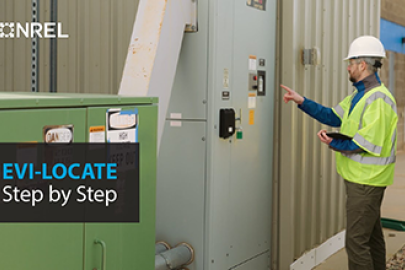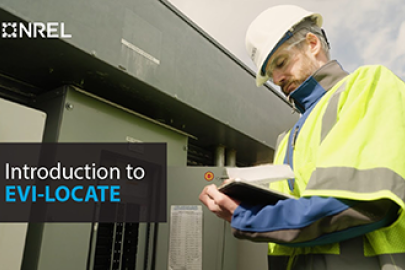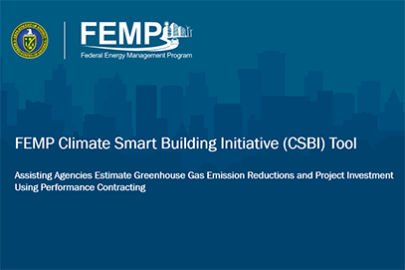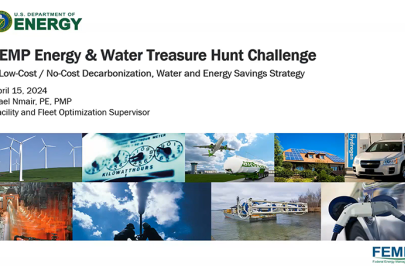This training focuses on energy-efficient lighting for federal commercial and industrial applications, including what's mandatory and what else you need to know about LED lighting to select and buy the product that best meets your facility's needs.
Federal Energy Management Program
September 29, 2023Got five minutes? The Take Five training series has you covered with very short trainings in buying clean, efficient goods and services for the federal government while doing your part to reduce carbon emissions.
This training focuses on energy-efficient lighting for federal, commercial, and industrial applications. We cover what's mandatory for federal facilities and what else you need to know about LED lighting to select and buy the product that best meets your facility's needs.
Hello and welcome to Take Five, a series of quick lessons in sustainable purchasing. I'm Meena Venkatraman of Berkeley Lab, and today I'll cover how to buy energy efficient and long-lasting lighting for your commercial and industrial buildings. Since the U.S. government is the nation's largest energy consumer, federal agencies have a great opportunity to help achieve energy resilience and security by buying efficient products and services. But how exactly do you make sure that the lighting product you purchase is energy efficient?
To help you buy efficient lighting, I'll go over five key points today.- What are some useful lighting terms
- Why buy LED lighting
- What are the federal efficiency requirements
- How to find compliant lighting
- How to buy lighting that meets your needs
By the end, you'll know how to quickly and easily buy the best product that helps your agency meet its lighting needs, comply with federal law, save money, and help address climate change.
First, let's cover some useful lighting terms you may need to know. Technically, what most of us know as light bulbs are also called lamps. Lamps are part of light fixtures, also called luminaires, which have one or more lamps, plus wiring, sockets, and so on. A common type of light fixture in federal offices is a troffer, those rectangular light fixtures installed in the ceiling. Now, for any kind of lighting, you'll want it to be efficient, which is why we're talking about LEDs, or solid-state lighting. Energy efficiency is how much light you get out for much energy you put in. The key unit is called luminous efficacy, measured as lumens - or how much light is shining - per Watt.
And in terms of energy efficiency and versatility, as lighting goes, you can't do much better than LEDs. LED fixtures can not only provide energy and cost savings for lighting, they last longer too, which saves on O&M costs. LEDs also have greater functionality, such as more options for automated controls, light warmth, and brightness. LEDs can even help building occupants be more alert, productive and improve their wellbeing by mimicking the rhythm of natural light.
So how do you find LED lighting that meets federal efficiency requirements? To give an example, let's look for a commercial 2 ft x 4 ft LED troffer, which is a very common type of LED fixture. The best place to start is the Sustainable Facilities Tool, or SFTool.gov, sponsored by the General Services Administration (GSA). SFTool is your one-stop shop for sustainable procurement. In SFTool, you can search for LED fixtures in the search bar at the top or find it under the Procure tab in the Lighting and Ceiling Fans section. From here, you can select the kind of fixture you're looking for - in this case, LED luminaires.
Once you select the product type, the product page tells you the applicable procurement requirements. Federal agencies are required to purchase products that are either certified by the Environmental Protection Agency's ENERGY STAR program or designated by the Department of Energy's Federal Energy Management Program (FEMP). Since lighting products are FEMP-designated, you can find the specific requirements by following the link under the Procurement Info section to the FEMP product page.
FEMP provides guidance, affordable solutions, and best practices to help federal agencies meet energy-related goals and requirements. LED luminaires have different requirements for luminous efficacy depending on the lighting type. For our commercial 2 ft x 4 ft LED troffer example, the product you buy should have a luminous efficacy of at least 132 lumens per watt. Apart from the efficiency requirement, on this page you can also find out how much money you can save by purchasing energy efficient lighting, as well as buyer and user tips to determine the right kind of lighting for your needs.
Now that you know the federal efficiency requirements, you can ask your preferred lighting vendor for a list of models at or above the required luminous efficacy level. You can also use any website that provides luminous efficacy information to find compliant lighting models. One source that includes this information is the DesignLights Consortium or DLC website. DLC is a nonprofit collaboration of manufacturers, building owners and government. They provide verified lists of high performing, energy efficient lighting products.
So let's consider our 2 ft x 4 ft LED troffer example and try to find a compliant model. You can make a free account and log into DLC, go to qualified products lists, and solid state lighting. Under reported performance criteria, adjust the reported efficacy range to meet the minimum FEMP efficiency requirement of 132 lumens per Watt. You can then choose a product from the search results. For each product, DLC provides product capabilities and performance information.
After choosing the model you want, you can buy it in several ways. You can take advantage of the GSA Multiple Award Schedules, which provide convenience and guaranteed lowest prices. The same SFTool product page we used before will take you to the relevant schedule on GSA Advantage. From there, you can find a vendor and pull up their latest price list.
Alternatively, in GSA eBuy, you can enter the product to get a quote from multiple vendors.
If you want to solicit bids on your own, you can also use the SFTool product page to find guidance and example contract language for specifying the required energy performance level in a solicitation.
With any of these methods, just make sure that the model meets the minimum FEMP efficiency requirements before finalizing the purchase.
So let's recap the product research and purchasing process, as well as the most useful links from the websites and the tools that we've gone over today. You can use the same links to help you understand federal efficiency requirements and purchase compliant models for other products designated by FEMP. For quick reference, you can find this information in the one pager accompanying this training.
To learn more, check out some of our other training, such as this full-length training on energy efficient lighting and our previous Take Five video on buying air source heat pumps. We hope you'll also join us for our upcoming training on communicating sustainability requirements for an acquisition. Thanks for tuning in to this edition of Take Five, and thank you for doing your part to meet federal policy, save taxpayer dollars, and address climate change.
[End of Audio]
Download a one-page guide to buying energy-efficient lighting.
Learn more about Energy-Efficient Product Procurement Training for Federal Agencies.










